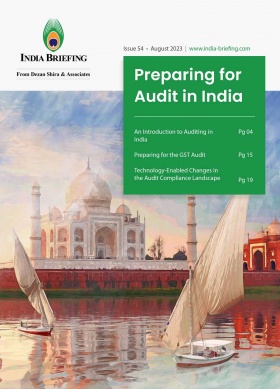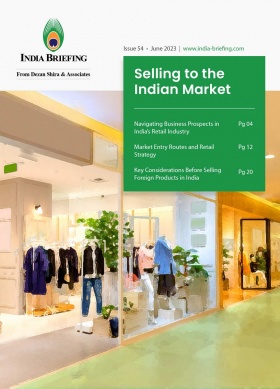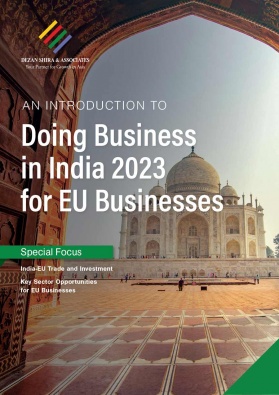The Foreign Investment Outlook of India’s Pharmaceuticals Industry
India’s pharmaceutical industry is among the leading global producers of cost-effective generic medicines and vaccines, supplying 20 percent of the total global demand by volume and 60 percent of the global demand for vaccines. Foreign investment rules are liberal for this industry, with 100 percent FDI allowed.
India’s pharmaceutical industry is currently ranked third globally for pharmaceutical production by volume and 14th by value. The country has a well-established domestic pharmaceutical industry, featuring a network of around 3,000 drug companies and approximately 10,500 manufacturing units.
The future of this industry appears promising, with the Indian pharmaceutical products market projected to achieve a value of approximately US$130 billion by the end of 2030. Concurrently, the global pharmaceutical products market is expected to surpass the US$1 trillion mark in 2023.

Foreign direct investment
Greenfield pharmaceutical undertakings in India are allowed 100 percent foreign direct investment (FDI) through the automatic route. For brownfield pharmaceutical investments, 100 percent FDI is permitted but with 74 percent under the automatic route and the remainder requiring approval from the Indian government.
In the greenfield category, companies establish their subsidiary and start their own production by constructing new plants or facilities from the ground up. Whereas, under brownfield investment, companies buy or lease existing facilities to begin a new production activity.
The cumulative FDI equity inflow into the drugs and pharmaceuticals industry in India from April 2000 to December 2022 was US$21.22 billion, accounting for nearly 3 percent of the total FDI inflow across all sectors. Indian pharmaceutical companies have firmly established their presence in the prescription markets of the US and EU, with a substantial number of US FDA-approved manufacturing facilities operating in India.
Major investors in India’s pharmaceutical industry are AstraZeneca, Dr. Reddy’s, GSK, Divi’s, Zydus, Novartis, Pfizer, Sun Pharma, Teva, Mylon, and Johnson & Johnson.

Industry outlook
The Indian pharmaceutical industry currently holds a market share worth approximately US$50 billion. Industry analysts project it to grow at a compound annual growth rate (CAGR) of 10.7 percent through 2030. It is anticipated that the pharmaceutical market in India will surge to US$65 billion by 2024 and double by 2030, reaching US$130 billion.
India is currently the second-largest contributor to the global biotech and pharmaceutical workforce.
Key segments in the Indian pharmaceutical industry
The Indian pharmaceutical industry, often known as the “Pharmacy of the world,” plays a pivotal role globally. It covers a wide spectrum, including the development of generic drugs, over-the-counter (OTC) medicines, bulk drugs, vaccines, contract research, biosimilars, and biologics.
India’s significance in vaccine production is remarkable, particularly in DPT, BCG, and Measles vaccines. India contributes to 60 percent of global vaccine production, fulfilling up to 70 percent of WHO’s DPT and BCG vaccine demand, as well as 90 percent of the measles vaccine demand.
Additionally, India is the world’s largest provider of generic medicines, with a 20 percent global supply share by volume. The country hosts over 3,000 pharmaceutical companies, supported by 10,500 manufacturing facilities and a skilled workforce.
India has about 500 active pharmaceutical ingredient (API) manufacturers, contributing 8 percent to the global API industry. Its production of 60,000 generic brands spanning 60 therapeutic categories accounts for 20 percent of global generics supply. India’s role in providing affordable HIV treatment is globally recognized, making Indian medicines preferred choices worldwide.
Pharmaceutical clusters in India
According to the survey report by the Department of Pharmaceuticals in February 2023, there is a robust network of 118 pharmaceutical clusters that span over 19 states and union territories.
Maharashtra leads the tally with the highest number of 40 pharma clusters.
|
State / Union Territory |
Number of Pharmaceutical Clusters |
|
Maharashtra |
40 |
|
Gujarat |
13 |
|
Andhra Pradesh |
8 |
|
Himachal Pradesh |
7 |
|
Rajasthan |
7 |
|
Uttar Pradesh |
6 |
|
Goa |
5 |
|
Karnataka |
5 |
|
Tamil Nadu |
5 |
|
Haryana |
3 |
|
Uttarakhand |
3 |
Besides the above regions, Punjab, Chhattisgarh, Madhya Pradesh, Odisha, Puducherry, Sikkim, West Bengal, and Jharkhand are also home to pharmaceutical clusters.
Pharmaceutical production and medical device manufacturing in Telangana State
Hyderabad, the capital of Telangana state in south-central India, is unofficially called the vaccine capital of the world by its government. Over half of the world’s vaccines could be manufactured in the city by 2024, per the state’s Industries and Commerce Minister KT Rama Rao, speaking to the media in June. The Hyderabad Pharma City also aims to become the world’s largest pharmaceutical cluster.
Besides pharma production, the state of Telangana also hosts the country’s largest medtech R&D, innovation, and manufacturing cluster at the Medical Devices Park, Sultanpur, Patancheru. Investors in the Park include Medtronic and B-Braun.
Products manufactured in the Sultanpur Medical Devices Park include orthopaedic implantation, ultrasound scanners, sterile kits, single-use needles, surgical, ophthalmic, and cosmetic medical devices and medical dressings, dental and maxillofacial implants, prosthetics, minimally invasive coronary stent system and its related accessories, disinfectants, hospital HVAC (Protective Environment Control) systems , etc.
Made in Telangana stents and catheters are now exported to over 89 markets, including the US, Europe, Japan, Australia, and New Zealand.
According to the Department of Pharmaceuticals report, there are currently 7,673 pharmaceutical industries in operation, averaging 65 units per cluster. Notably, there are significant pharmaceutical clusters in Taloja, Maharashtra, as well as in Visakhapatnam, Tirupati, and NTR-Krishna-Palnadu in Andhra Pradesh, each hosting over 400 pharmaceutical industries.
Furthermore, the annual domestic pharmaceutical production by the industries within 117 pharmaceutical clusters across the country is estimated to be around 611,120 tonnes. Additionally, the annual export value of pharmaceutical products from these clusters totals approximately 576,140 tonnes.
Segments in the Indian pharmaceutical industry
Active pharmaceutical ingredients
Active pharmaceutical ingredients represent a crucial component within the pharmaceutical industry, constituting approximately 35 percent of the market. These APIs serve as the biologically active constituents of drugs, responsible for inducing the intended medical effects. India stands as the 3rd largest producer of APIs, holding an 8 percent share in the global API Industry. With the manufacturing of over 500 different APIs, India contributes 57 percent of APIs to the prequalified list of the World Health Organization (WHO).
Key players in the India API market include Solara, Aurobindo Pharma Limited, Dr. Reddy’s Laboratories, Lupin Limited, Sun Pharmaceutical Industries Limited, Divi’s Laboratories Ltd., Aarti Drugs Ltd., Neuland Labs, Century Pharmaceuticals Ltd., and Proventus Life Sciences Pvt Ltd., per research from Invest India.
Biosimilars
The Indian biosimilars market is poised to witness a substantial growth trajectory, with an estimated CAGR of 22 percent, reaching a value of US$12 billion by 2025. This expansion would signify nearly 20 percent of the entire pharmaceutical market in India.
Formulations
In terms of volume, India ranks as the largest exporter of formulations, commanding a 14 percent market share and securing the 12th position in terms of export value. The industry anticipates a double-digit growth rate over the upcoming five years.
Packaging
Per industry researchers, the Indian pharmaceutical packaging market was valued at US$1.4 billion in 2020, with projections to reach US$3.02 billion or US$3.25 billion by 2030, at a CAGR of 7.54 percent or 9.7 percent, respectively.
According to data from Mordor Intelligence, the pharmaceuticals market size in India was projected to reach US$15.75 billion in 2023 and US$29.41 billion by 2028, the latter at a CAGR of 13.30 percent.
OTC drugs
The OTC drug market in India was valued at INR 448,19 billion (US$5.38 billion) in 2022, per data from ResearchAndMarkets. In 2022, vitamins and minerals dominated the OTC drugs market with a significant share of 36.84 percent. Furthermore, the segment of cold and cough remedies is anticipated to experience rapid growth, attributed to the significant climate changes witnessed recently and rise of air pollution.
Contract Research and Manufacturing Services (CRAMS)
Contract Research and Manufacturing Services (CRAMS) has emerged as among the swiftly expanding segments within the Indian pharmaceutical and biotechnology industry. Pharmaceutical companies engage in outsourcing services through contract research organizations (CROs) and contract manufacturing organizations (CMOs) to meet various research and manufacturing needs.
India’s pharmaceutical exports in FY23
Indian drugs find their way to over 200 countries worldwide, with the United States, Belgium, South Africa, UK, and Brazil serving as the top five destination markets. The exports of Indian drugs and pharmaceuticals grew to INR 2.04 trillion (US$24.51 billion) in 2022-23, constituting 5.71 percent of the country’s total exports.


India’s exports of pharmaceutical products rose to 2.37 times in April-February 2022-23. – Piyush Goyal, Minister of Commerce & Industry
India accounts for 20 percent of the global exports of generic drugs and its key market is North America. India accounts for 60 percent of global vaccine output and is a significant source of affordable vaccines.
Under the Vaccine Maitri initiative (as on May 19, 2023), India had delivered more than 298 million COVID-19 vaccine doses to approximately 100 countries worldwide. Prominent research institutions in India are the Indian Council of Medical Research (ICMR) and the National Institute of Virology (NIV).
India’s medical device exports witnessed a robust 16.15 percent growth in FY 2022-23, reaching INR 278.18 billion (US$3.34 billion), up from the INR 239.50 billion (US$2.87 billion) reported in the previous fiscal year.
Key growth drivers for India’s pharmaceutical industry
India’s pharmaceutical industry is shaped by a multitude of factors that fuel its growth and development. We discuss a few key drivers and developments below.
Supply-side drivers
- The introduction of product patents has opened the doors for the launch of patented drugs, attracting numerous multinational companies to the Indian market. A recent High Court decision permitting the export of patented drugs to foreign firms further boosts the industry’s momentum.
- The emphasis on strengthening medical infrastructure is a significant draw for private sector players. With a skilled workforce and strong managerial and technical capabilities, pharmaceutical companies are directing investments towards rural markets and improving healthcare infrastructure.
- The establishment of Medical Devices Parks in Andhra Pradesh, Telangana, Tamil Nadu, and Kerala is part of a strategic effort to create state-of-the-art infrastructure facilities, positioning India’s medical device sector as a global leader.
- The anticipated expiration of around 120 drugs in the next decade, with estimated worldwide revenues ranging from US$80-250 billion, is poised to impact market dynamics significantly.
- In 2022, the central government proposed including 16 common drugs for cough, cold, and pain in the OTC category in India, allowing their retail sale without a doctor’s prescription, in accordance with an amendment to the Drugs and Cosmetics Rules.
- In August 2023, the National Medical Commission released a list of therapeutic categories of drugs to be classified as OTC, eliminating the need for a health professional’s prescription. These categories encompass anti-hemorrhoid drugs, topical antibiotics, cough suppressants, anti-acne drugs, non-steroidal anti-inflammatory medicines, as well as antiseptics, analgesics, decongestants, aspirin, vasodilators, antacids, expectorants, anti-fungal drugs, anti-histamines, anti-flatulence agents, and smoking cessation drugs.
Demand-side drivers
- Increased acceptance: A growing level of education is fostering greater acceptance of pharmaceuticals. This has led to a stronger inclination toward self-medication, thereby boosting the OTC market.
- Biologics and preventive medicines: There is a noticeable surge in the acceptance of biologics and preventive medicines, reflecting changing healthcare preferences.
- Medical tourism: The rise in medical tourism, characterized by an influx of patients from various countries, is further stoking demand for pharmaceutical products.
- Enhanced accessibility: Projections of over US$200 billion in investments for medical infrastructure in the next decade, as reported by McKinsey, are set to significantly improve accessibility. These investments are expected to give rise to new business models, reaching tier-2 and tier-3 cities and making healthcare more accessible.
- Increased hospital bed capacity: The addition of over 160,000 hospital beds annually over the next decade is anticipated to enhance access to healthcare services across the country.
- Epidemiological factors: Epidemiological factors, such as an expected increase of over 20 percent in the patient population by 2030 due to population growth, the emergence of new diseases, and changes in lifestyle, are poised to further drive demand for pharmaceutical products.
Government support
PLI Schemes
The Government of India has initiated three Production Linked Incentive (PLI) Schemes: Bulk Drugs (2020), Medical Devices (2020), and Pharmaceuticals (2021). These schemes aim to achieve self-reliance, enhance domestic manufacturing, and draw significant investments to the sector.
Financial incentives are disbursed under the PLI Schemes based on the term of the scheme, the company’s committed investment, and actual sales made by the selected applicant for the eligible products. Hence, selected beneficiaries do not automatically qualify for incentives and must meet the Scheme criteria during audit.
There are four segments into which eligible key starting materials (KSMs)/drug intermediaries (DIs)/APIs products have been divided, under the PLI Scheme, based on their criticality and import dependence:
- Key fermentation based KSMs/DIs
- Niche fermentation based KSMs/DIs/APIs
- Key chemical synthesis based KSMs/DIs
- Other chemical synthesis based KSMs/DIs/APIs
Status as of February 2023:
India has commenced the production of 22 APIs or bulk drugs under the PLI Scheme. These APIs are needed for the manufacturing of life-saving drugs and advanced medical devices like CT scan and MRI machines. Presently, India grapples with an 85 percent import reliance on APIs, mostly from China, and an 80 percent dependency on medical device imports. Annually, India imports APIs worth INR 350 billion (US$4.20 billion), and China, being a dominant player in APIs, supplies these vital inputs for even fundamental drugs like painkillers.
In February 2023, the Department of Pharmaceuticals (DoP) disbursed the initial tranche of incentives under the PLI scheme for pharmaceuticals, amounting to INR 1.66 billion (US$19.93 million), distributed among four selected applicants.
The PLI scheme for bulk drugs, which possesses a total financial allocation of INR 69.4 billion (833.62 million), aims to invigorate the domestic production of 41 essential bulk drugs in the country.
So far, 51 projects have been selected for the 34 notified bulk drugs. Out of this, 22 projects have been commissioned till date (for projects of fermentation-based APIs, the production year as per the scheme guidelines is FY 2023-24). – Union health minister Mansukh Mandaviya
The table below provides an overview of the investments received under the PLI Schemes as of March 2023:
|
S. No. |
PLI Scheme |
Investment received as of March 2023 (in INR) |
|
1 |
Bulk Drugs |
24.05 billion |
|
2 |
Medical Devices |
8.37 billion |
|
3 |
Pharmaceuticals |
186.18 billion |
|
Total |
218.61 billion |
National Medical Devices Policy
Under the National Medical Devices Policy, 2023, approved by the government in April this year, India hopes to streamline industry regulations, facilitate R&D and innovation, establish key infrastructure, promote brand awareness and attract foreign investments, as well as enable skill development.
About Us
India Briefing is produced by Dezan Shira & Associates. The firm assists foreign investors throughout Asia from offices across the world, including in Delhi and Mumbai. Readers may write to india@dezshira.com for more support on doing business in India.
We also maintain offices or have alliance partners assisting foreign investors in Indonesia, Singapore, Vietnam, Philippines, Malaysia, Thailand, Italy, Germany, and the United States, in addition to practices in Bangladesh and Russia.
- Previous Article India Mandates Quality Norms for Copper Products, Drums, and Tin Containers to Boost Domestic Manufacturing
- Next Article Key Considerations Before Selling Foreign Products in India









